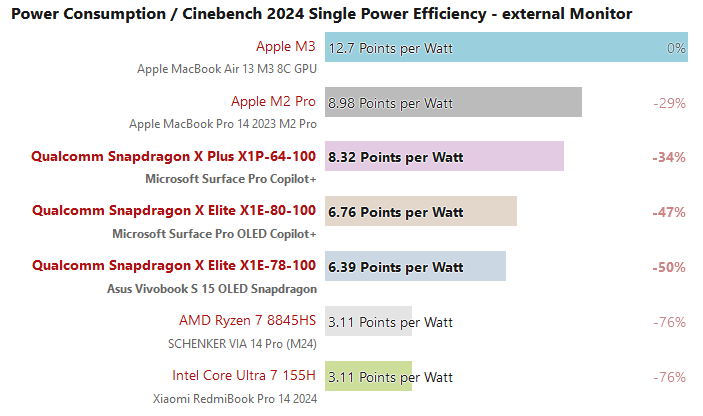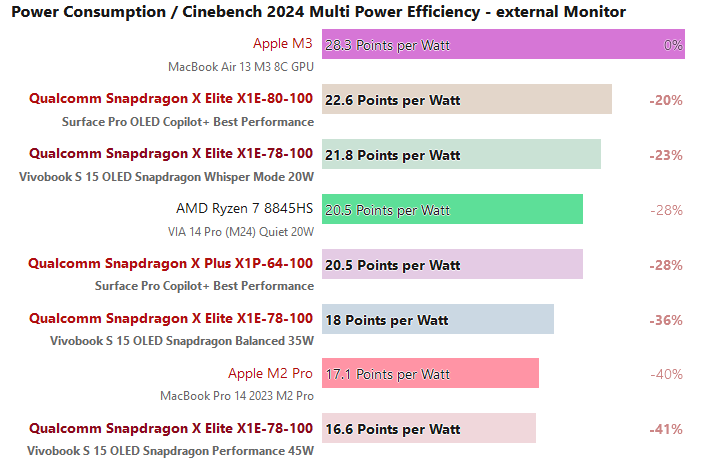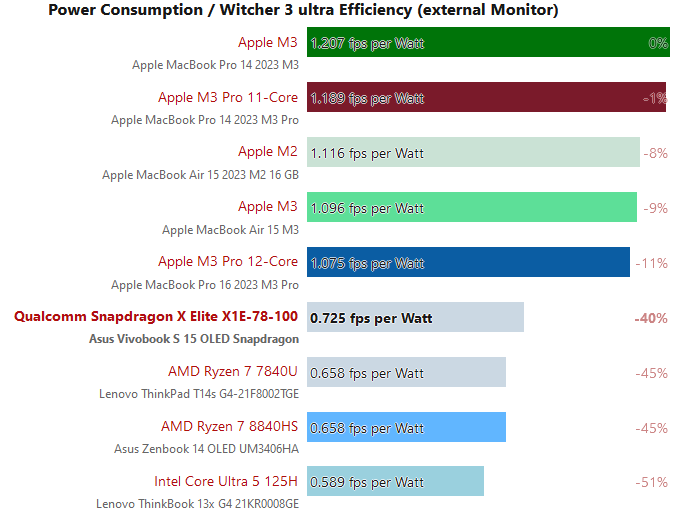they still have the lead, here are some screenshots from notebookcheck



e
they still have the lead, here are some screenshots from notebookcheck



I would never use MacOS myself but I get the ‘it just works’ aspect and the crazy energy efficiency of Apple’s hardware, also some tech youtubers I respect like Jeff Geerling and JDH use it
Now, iOS on the other hand… (I was seeing if a family member’s ipad would work as a drawing tablet for Blender recently using the Moonlight app (which actually supports pressure sensitivity btw), but USB streaming doesn’t work because apple ties that to its hotspot and therefore having cellular, and the 3rd party apps are all removed from the app store, its just so stupid that I have the ipad and the cable and yet I can only transfer data over wifi)
honestly if I heard someone say “I technically have linux with me right now” I would expect them to pull out an Android phone and say that Android is based on the Linux kernel (it is, its just not what anyone means when they say ‘linux’, its a pretty good example of how ‘linux’ refers to the OS and not the kernel)


Did they make money? obviously not.
Will it help them make money in the future? nobody knows. Probably not as much as it could have, we’ll have to wait and see.
I know a lot of people are fine with a paid plan, I’ve just seen what has happened to some projects like Fusion 360 where they slowly take away more and more features from the free version, slowly decrease support, and all new features go to the pro version. I would be surprised if this happens to ubuntu, but I don’t want to take that chance.
You’re acting like there isn’t another option. I could just go use Arch with KDE Plasma or something instead, or maybe Fedora which is at least somewhat separated from the ‘pro version’ (red hat)
Out of all of the projects that I can think of in recent memory that started as big open source useful things, only VLC Media Player managed to avoid turning into garbage, and it’s because the lead developer is a saint.
the Linux Kernel, Blender, Godot, Lemmy are some examples that come to mind, or maybe I’m just not understanding what you’re trying to say here
I’m never going to feel fully satisfied using an OS that has an official ‘pro’ version.


for game development apparently godot has a standalone version for Meta headsets, but it doesn’t really work on the Vision Pro other than some community version that only allows it to display 3d models in small bounds because of OS restrictions, theoretically it should work immersively with WebXR but I don’t really know (and then you have to limit your game to what can feasibly be downloaded in a few seconds)


Youtube discontinued their thing for SteamVR, and yet people still use SteamVR.


I think according to basically everyone even something like Pokemon Go counts as AR, but I get your point.


this does raise a good question, if apple intended this as specifically being for developers, why aren’t they marketing it as such and encouraging devs that they will release a cheaper headset later?


there have always been a subset of vr headsets where the displays and optics are good but are otherwise flawed, that have been relegated to the flight sim and sim racing world lol
(I have a reverb g2 and use it for ‘normal’ vr games, but I understand its most popular among sim people, I think Pimax headsets generally see similar use)
(also apple has told no one about ALVR and other streaming, the basically only people who will know about it are the people who liked and were using VR already and probably already have a headset they are generally satisfied with, so I doubt it has significantly affected their sales, they still shot themselves in the foot by pretending that Fruit Ninja or whatever was the only game that people would want to play with their headset)


theoretically with webxr and webgpu you should be able to do just about anything on the web that you can do in an app, although I guess its more effort since you basically have to make the game engine yourself


there is a big difference between those 3d effects and actual vr, where with one you only get the primitive depth idea your brain produces versus actually being able to inspect something from any angle
it also enables very different inputs, like with beat saber or rumble for example, or recently I was imagining a game where you can point at something to grapple on to it while using the other controller to shoot at enemies at the same time which wouldn’t really work without vr
unfortunately for me i’m someone who is interested in computer graphics and the difference in immersion from vr is largely offset by the graphics being worse, the screens looking worse and blurrier, the lack of an actual focus depth (I forget what the technical term for this is but most headsets have everything set so your eyes always focus at what would normally by 1-2 meters away), and the new perspective exposing all of the little graphics tricks that don’t really work when you can see them in this level of detail
(i’d say an ideal headset would probably have 6x more pixels than my reverb g2 (/3.5 px because it would also have foveated rendering) and be able to render visuals similar to cyberpunk at ‘rt ultra’, with apparently already gets 90 fps on a 4090 at 1080p, so that would be 7.5x more pixels, you would need a card 7.5x faster than a 4090, so assuming Moore’s Law stays accurate that should be around 12 years from now)
so why hasn’t vr taken off? I would say (in no particular order) it’s because it hurts your eyes, makes you dizzy, is uncomfortable, its expensive, it doesn’t have many apps, the controls feel janky for actual ui stuff where a mouse and keyboard is just easier, people are lazy and it requires some physical activity, people don’t have all that much free time
don’t take this the wrong way, I generally love VR and have probably 150-200 hrs in it over two years (a lot less than a some people, if you look at the reviews for vr chat for example its not uncommon for people to have >5k hours)


apple is worth trillions of dollars, a few million is nothing to them


gambling (both lootboxes and the skin site kind), big fees


a court case also draws out media coverage, possibly more than an extended search would


antialiasing and denoising through temporal reprojection (using data from multiple frames)
it works pretty well imo but makes things slightly blurry when the camera moves, it really depends on the person how much it bothers you
its in a lot of games because their reflections/shadows/ambient occlusion/hair rendering etc needs it, its generally cheaper than MSAA (taking multiple samples on the edges of objects), it can denoise specular reflections, and it works much more consistently than SMAA or FXAA
modern upscalers (DLSS, FSR, XeSS) basically are a more advanced form of taa, intended for upscaling, and use the ai cores built into modern gpus. They have all of the advantages (denoising, antialiasing) of taa, but also generally show blurriness in motion.
“The surge of emotion that shot through me when I saved your life taught me an even more valuable lesson: where woke_mind_virus lives in my brain. [Announcer: “woke_mind_virus deleted.”] Goodbye, woke_mind_virus.”